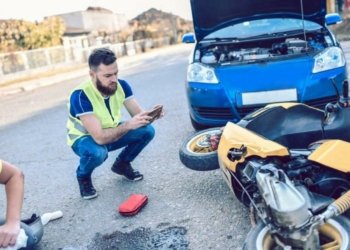Car accidents are a common occurrence on our roads, and they can happen to anyone at any time. While some accidents are minor and only result in a few dents or scratches, others can be severe, causing significant physical, emotional, and financial damage. As such, it’s crucial to be aware of the different types of car accidents that can occur to help you when hiring a car accident lawyer. Here are five of the most common types of car accidents and insights on how to avoid them, helping you and your loved ones stay safe on the road:
Rear-end collisions
You risk rear-ending another vehicle if you follow another vehicle too closely or if the other driver brakes abruptly. These collisions are the most frequent, although they typically do not cause much damage. The way to avoid them is to maintain a safe following distance from other vehicles. Even in slow traffic, tailgating endangers both you and other drivers.

Single-vehicle crashes
Single-vehicle crashes are accidents in which only one vehicle is involved. These accidents can occur due to various reasons, such as driver error, weather conditions, road defects, or vehicle malfunction. Driver error is one of the most common reasons for single-vehicle crashes, which can be caused by distracted driving, speeding, drowsiness, drunk driving, or reckless behavior.
Weather conditions can also play a significant role in single-vehicle crashes. Rain, snow, ice, and fog can cause reduced visibility and slippery roads, making it difficult for drivers to maintain control of their vehicles. Road defects such as potholes, debris, or uneven surfaces can also cause single-vehicle crashes.
Vehicle malfunction is another common cause of single-vehicle crashes. Mechanical issues such as faulty brakes, tire blowouts, or steering problems can lead to loss of control of the vehicle, resulting in a single-vehicle crash.
In order to prevent single-vehicle crashes, it’s essential to practice safe driving habits, such as avoiding distractions, obeying traffic laws, maintaining a safe speed, and wearing a seat belt. It’s also crucial to ensure that your vehicle is well-maintained and regularly checked for any mechanical issues that could lead to a single-vehicle crash.
Crashes at Intersections/T-Bone Accidents
One location where accidents regularly happen is at intersections. Crashes at intersections, also known as T-bone accidents, occur when two vehicles collide at a right angle at an intersection. These types of accidents can result in severe injuries or even fatalities, especially if one of the vehicles is traveling at high speed.
The most common causes of intersection crashes include drivers running red lights or stop signs, failing to yield the right of way, and turning left in front of oncoming traffic. These accidents can also be caused by poor visibility due to weather conditions, obstructed views, or inadequate road signage. Defensive driving can help you prevent accidents. When the light turns green, wait to ensure nobody is approaching the intersection. Beware of drivers who attempt to beat a yellow light by driving too quickly.
Side-swipe accidents
Accidents involving side swipes are frequent on busy, multi-lane streets. Most of the time, aggressive drivers are to blame for these incidents. When someone is driving irately, they might cut someone off without blinking or adequately checking their blind spot. They might also change lanes too quickly, swiping the side of a parked car.
These mishaps may be severe and result in many kinds of injuries. The collision is likely to be fatal depending on which side of the car is swiped (the passenger side or the driver’s side).
Low-speed accidents
Impact collisions at low speeds might not be the worst type of car accident, but they can still cause harm. Parking lots and residential neighborhoods are frequent locations for these fender-benders, bumps, parking lot collisions, and other crashes under 10 miles per hour, putting pedestrian lives in danger. In residential areas and other regions with many pedestrians, you must always be alert for pedestrians and never drive too fast. Accidents involving pedestrians can cause catastrophic injuries, even at low speeds. Take extra precautions to watch out for other drivers before reversing because many low-speed crashes occur when drivers are backing up.
Unfortunately, we can’t always shield ourselves from mishaps despite our best efforts. People who drive carelessly may be held accountable for the harm they create.
Conclusion
Accidents do not just happen; humans actually cause them. Keep a safe distance; drive far enough behind the car in front of you so that you can stop safely. This is especially true in poor weather conditions.
Drive defensively. Avoid situations that could force you to use your brakes suddenly if a driver follows you too closely or needs to pay attention.
Don’t drive when tired or under the influence. You are more likely to make driving errors when sleepy or impaired by drugs or alcohol.




















